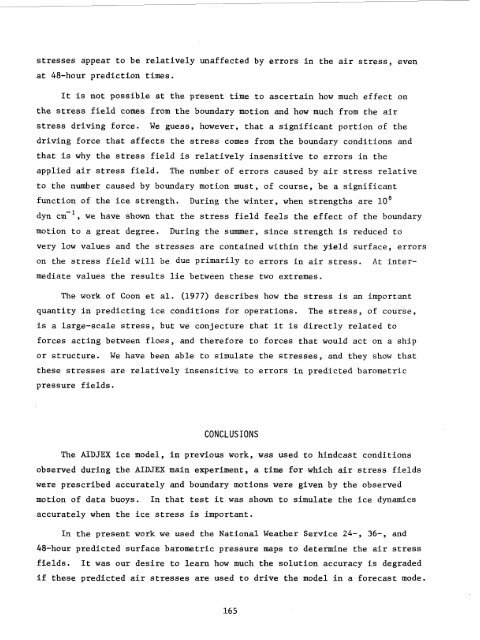AIDJEX Bulletin #40 - Polar Science Center - University of Washington
AIDJEX Bulletin #40 - Polar Science Center - University of Washington
AIDJEX Bulletin #40 - Polar Science Center - University of Washington
You also want an ePaper? Increase the reach of your titles
YUMPU automatically turns print PDFs into web optimized ePapers that Google loves.
stresses appear to be relatively unaffected by errors in the air stress, even<br />
at 48-hour prediction times.<br />
It is not possible at the present time to ascertain how much effect on<br />
the stress field comes from the boundary motion and how much from the air<br />
stress driving force. We guess, however, that a significant portion <strong>of</strong> the<br />
driving force that affects the stress comes from the boundary conditions and<br />
that is why the stress field is relatively insensitive to errors in the<br />
applied air stress field. The number <strong>of</strong> errors caused by air stress relative<br />
to the number caused by boundary motion must, <strong>of</strong> course, be a significant<br />
function <strong>of</strong> the ice strength. During the winter, when strengths are LO8<br />
dyn cu-l, we have shown that the stress field feels the effect <strong>of</strong> the boundary<br />
motion to a great degree. During the summer, since strength is reduced to<br />
very low values and the stresses are contained within the yield surface, errors<br />
on the stress field will be due primarily to errors in air stress. At intermediate<br />
values the results lie between these two extremes.<br />
The work <strong>of</strong> Coon et al. (1977) describes how the stress is an important<br />
quantity in predicting ice conditions for operations. The stress, <strong>of</strong> course,<br />
is a large-scale stress, but we conjecture that it is directly related to<br />
forces acting between floes, and therefore to forces that would act on a ship<br />
or structure. We have been able to simulate the stresses, and they show that<br />
these stresses are relatively insensitive to errors in predicted barometric<br />
pressure fields.<br />
CONCLUSIONS<br />
The <strong>AIDJEX</strong> ice model, in previous work, was used to hindcast conditions<br />
observed during the <strong>AIDJEX</strong> main experiment, a time for which air stress fields<br />
were prescribed accurately and boundary motions were given by the observed<br />
motion <strong>of</strong> data buoys. In that test it was shown to simulate the ice dynamics<br />
accurately when the ice stress is important.<br />
In the present work we used the National Weather Service 24-, 36-, and<br />
48-hour predicted surface barometric pressure maps to determine the air stress<br />
fields. It was our desire to learn how much the solution accuracy is degraded<br />
if these predicted air stresses are used to drive the model in a forecast mode.<br />
16 5








